外研版八年级英语上Module 1 Unit 1 导学案
- 格式:docx
- 大小:14.78 KB
- 文档页数:3
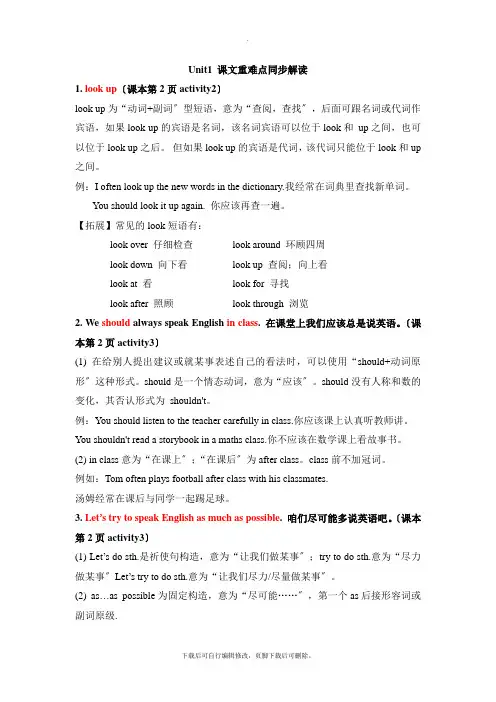
Unit1 课文重难点同步解读1. look up〔课本第2页activity2〕look up为“动词+副词〞型短语,意为“查阅,查找〞,后面可跟名词或代词作宾语,如果look up的宾语是名词,该名词宾语可以位于look和up之间,也可以位于look up之后。
但如果look up的宾语是代词,该代词只能位于look和up 之间。
例:I often look up the new words in the dictionary.我经常在词典里查找新单词。
You should look it up again. 你应该再查一遍。
【拓展】常见的look短语有:look over 仔细检查look around 环顾四周look down 向下看look up 查阅;向上看look at 看look for 寻找look after 照顾look through 浏览2. We should always speak English in class. 在课堂上我们应该总是说英语。
〔课本第2页activity3〕(1) 在给别人提出建议或就某事表述自己的看法时,可以使用“should+动词原形〞这种形式。
should是一个情态动词,意为“应该〞。
should没有人称和数的变化,其否认形式为shouldn't。
例:You should listen to the teacher carefully in class.你应该课上认真听教师讲。
You shouldn't read a storybook in a maths class.你不应该在数学课上看故事书。
(2) in class意为“在课上〞;“在课后〞为after class。
class前不加冠词。
例如:Tom often plays football after class with his classmates.汤姆经常在课后与同学一起踢足球。
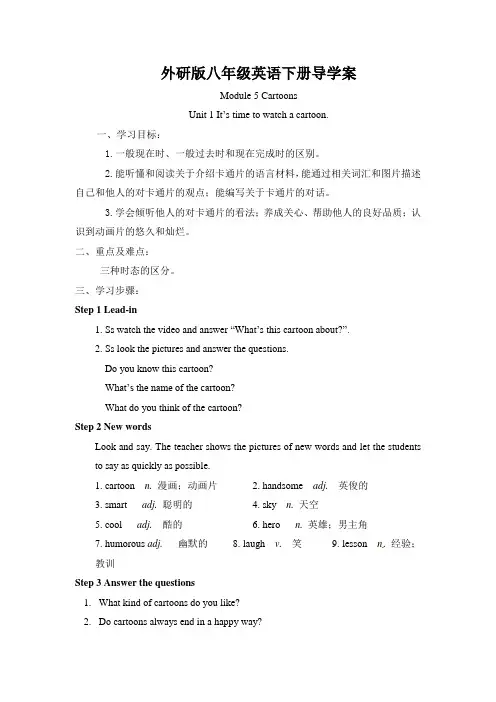
外研版八年级英语下册导学案Module 5 CartoonsUnit 1 It’s time to watch a cartoon.一、学习目标:1.一般现在时、一般过去时和现在完成时的区别。
2.能听懂和阅读关于介绍卡通片的语言材料,能通过相关词汇和图片描述自己和他人的对卡通片的观点;能编写关于卡通片的对话。
3.学会倾听他人的对卡通片的看法;养成关心、帮助他人的良好品质;认识到动画片的悠久和灿烂。
二、重点及难点:三种时态的区分。
三、学习步骤:Step 1 Lead-in1. Ss watch the video and answer “What’s this cartoon about?”.2. Ss look the pictures and answer the questions.Do you know this cartoon?What’s the name of the cartoon?What do you think of the cartoon?Step 2 New wordsLook and say. The teacher shows the pictures of new words and let the students to say as quickly as possible.1. cartoon n.漫画;动画片2. handsome adj. 英俊的3. smart adj. 聪明的4. sky n. 天空5. cool adj. 酷的6. hero n. 英雄;男主角7. humorous adj. 幽默的8. laugh v. 笑9. lesson n.经验;教训Step 3 Answer the questions1.What kind of cartoons do you like?2.Do cartoons always end in a happy way?3.What cartoons do you think are funny?Step 4 Listening1. Listen to Part 2 and find out Betty’s and Tony’s answers to the questions in Activity 1.brave, cartoon, cute, funny, handsome, smart2. Now work in pairs and check. Do they like the same cartoons as you?3. Listen to Part 3 and answer the following questions.1) Wh at are Tony and Daming talking about?2) What does Daming think is better?Answers: 1. They are talking about cartoons.2. He thinks Superman is better.Step 5 Reading1.Now answer the questions.1. What does Tony think about Spiderman?2. Why does Daming think Superman is better?3. Why do they both like Tom and Jerry?4. What lesson can Tony learn from Tom and Jerry?Answers: 1. Spiderman can’t fly, but he climbs up buildings with his hands and feet. That’scool.2. Becaus e he’s stronger th an Spiderman. He can fly though the skyand fight badpeople.3. Because Tom and Jerry are very funny.4. They fight a lot, but t hey really love each other.Step 6 Everyday EnglishLet Ss say what they have learnt in the passage.Step 7 Language pointsSs should master the main points from the passage in Part 3.If possible, let the students to say at first.1. Do cartoons always end in a happy way? 卡通片常以快乐的方式结束吗?in a … way 表示“以一种…的方式”。
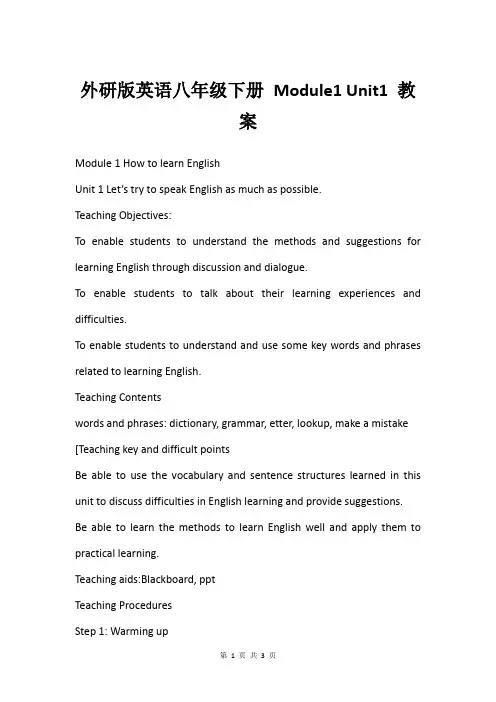
外研版英语八年级下册Module1 Unit1 教案Module 1 How to learn EnglishUnit 1 Let’s try to speak English as much as possible.Teaching Objectives:To enable students to understand the methods and suggestions for learning English through discussion and dialogue.To enable students to talk about their learning experiences and difficulties.To enable students to understand and use some key words and phrases related to learning English.Teaching Contentswords and phrases: dictionary, grammar, etter, lookup, make a mistake [Teaching key and difficult pointsBe able to use the vocabulary and sentence structures learned in this unit to discuss difficulties in English learning and provide suggestions.Be able to learn the methods to learn English well and apply them to practical learning.Teaching aids:Blackboard, pptTeaching ProceduresStep 1: Warming upGreet the students and ask them how they feel about learning English. Show them some pictures of different learning methods, such as reading, listening, speaking, writing, watching movies, playing games, etc. Ask them which methods they use or prefer and why.Lead in the topic of the unit: How to learn English.Step 2: Pre-listeningAsk the students to look at the title of the passage and guess what it is about.Ask the students to look at the pictures and the names of the four students in the passage. Ask them to predict what kind of learners they are and what difficulties they have in learning English.Step 3: While-listeningAsk the students to listen the passage quickly and check if their predictions are correct.Ask the students to listen the passage again and answer some comprehension questions, such as:1.What does Lingling suggest to Daming2.What does Tony do to improve his listening3.What does Betty do to improve her speaking4.What does Lingling do to improve her writingStep 4: Post-listeningAsk the students to work in pairs and discuss what they can learn fromthe four students in the passage. Ask them to share their own learning strategies and difficulties with their partners.Ask some pairs to report their discussions to the whole class. Summarize the main points of the passage and highlight some key words and phrases, such as:speak English as much as possiblelisten to tapeswatch English-language TVkeep a diary in Englishmake mistakesStep 5: HomeworkAsk the students to write a short paragraph about their own learning experiences and difficulties. Ask them to use some of the key words and phrases from the passage.Ask the students to try some new learning methods and see if they work for them.。
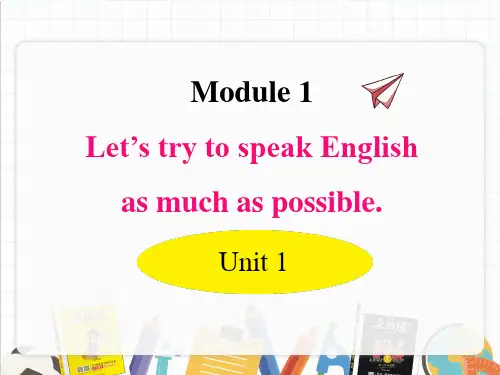

Module 1 How to learn EnglishUnit 1 Let's try to speak English as much as possible. 核心单词1. __pair__n.一对,(相关的)两个人2. __correct__v. 改正;纠正adj. 正确的;对的3. __practise__v. 练习4. __match__v. 找到与……相配之物,使相配;使成对5. __complete__v. 把……填完整;使完全6. __grammar____n. 语法7. __understand__v. 理解8. __mistake__n. 错误;过错9. __advice__n. 建议10. __notebook__n. 笔记本11. __forget__v. 忘;忘记12. __aloud__adv. 大声地13. __radio__n. 电台;广播14. __main__adj. 主要的15. __excellent__adj. 优秀的;极好的单词变形1. s pell→__spelling__(名词)2.possible→__possibly__(副词)3. pronounce→__pronunciation__(名词)4.agree→__agreement__(名词)5. meaning→__mean__(动词)6. dictionary→__dictionaries__(复数)核心短语1. __in__pairs__成对地,成双地2. __practise__doing__sth. __练习做某事3. __look__up__查;查找4. __welcome____back__欢迎回来5. __as__much__as__possible__尽可能多地6.__make__a__mistake__犯错误7. __forget__to__do__sth. __ 忘记要去做某事8. __so__many__那么多的9. __get__to__know__认识10. __agree__with__sb. __同意某人重点句型1. Why not __write__ __down__ our mistakes in our notebooks?为什么不把我们的错误写在我们的笔记本上呢?2. __It's__ __a__ __good__ __idea__ to spell and pronounce new words aloud every day.每天大声地拼读新单词是个好主意。

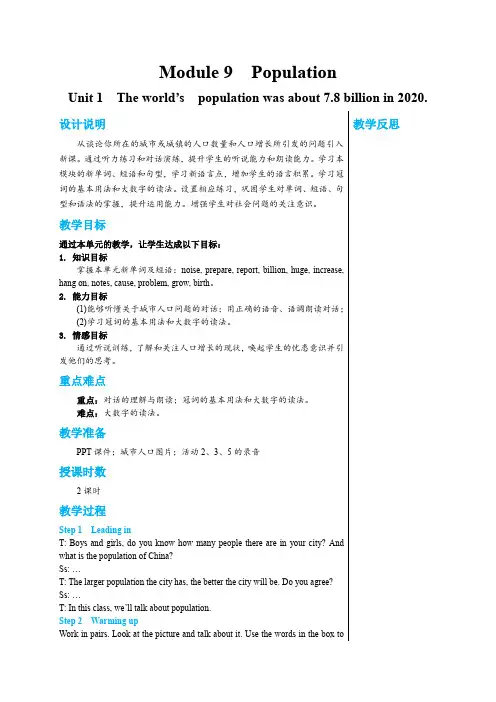
Module 9 PopulationUnit 1 The world’s population was about 7.8 billion in 2020. 设计说明教学反思从谈论你所在的城市或城镇的人口数量和人口增长所引发的问题引入新课。
通过听力练习和对话演练,提升学生的听说能力和朗读能力。
学习本模块的新单词、短语和句型,学习新语言点,增加学生的语言积累。
学习冠词的基本用法和大数字的读法。
设置相应练习,巩固学生对单词、短语、句型和语法的掌握,提升运用能力。
增强学生对社会问题的关注意识。
教学目标通过本单元的教学,让学生达成以下目标:1. 知识目标掌握本单元新单词及短语:noise, prepare, report, billion, huge, increase,hang on, notes, cause, problem, grow, birth。
2. 能力目标(1)能够听懂关于城市人口问题的对话;用正确的语音、语调朗读对话;(2)学习冠词的基本用法和大数字的读法。
3. 情感目标通过听说训练,了解和关注人口增长的现状,唤起学生的忧患意识并引发他们的思考。
重点难点重点:对话的理解与朗读;冠词的基本用法和大数字的读法。
难点:大数字的读法。
教学准备PPT课件;城市人口图片;活动2、3、5的录音授课时数2课时教学过程Step 1Leading inT: Boys and girls, do you know how many people there are in your city? Andwhat is the population of China?Ss: …T: The larger population the city has, the better the city will be. Do you agree?Ss: …T: In this class, we’ll talk about population.Step 2Warming upWork in pairs. Look at the picture and talk about it. Use the words in the box tohelp you. (Activity 1 on page 72)1. Ask the class to look at the picture and think what it shows.2. Tell the students to talk about the picture in pairs. It is a good way to describe the picture by asking and answering questions. For example:—What can you see in the picture?—I can see buildings, cars and a lot of people.—Is there much traffic in big cities?—Yes, there is.…Step 3ListeningListen and choose the correct answer. (Activity 2 on page 72)1. Write some large numbers on the blackboard and teach the students to read them.2. Ask the class to practise saying the numbers.3. Tell the students to read the questions and guess the answers with their partners.4. Play the recording and tell the students to listen for their answers.5. Play the recording once more for the students to check their answers.6. Check the answers with the students.Answers:1 b)2 c)7. Play the recording again and show the tapescript at the same time if necessary. Step 4Listening and reading1. Ask the class to listen to the recording.2. Complete the notes. (Activity 3 on page 73)(1) Ask the students to read the notes first. And then read the conversation and underline the key information.(2) Ask them to complete the notes with numbers.(3) Check the answers with their partners.Answers:about 7.8 billion; 8.5 billion; about 1.5 billion3. Read the conversation again and answer the questions.(1) Check the answers with their partners. Answers:1. He is preparing a report called “The world’s population”.2. It was about 7.8 billion in 2020.3. The largest increase in population will take place in India, Nigeria and Pakistan.(2) Ask the students to work in pairs to ask and answer the questions. 4. Find out the following phrases and translate them into Chinese. population world 世界人口 take place 发生 such as 例如 too much 太多population increase 人口增长 how about ……怎么样 hang on 稍等look after 照顾,照看 Thanks for 因……感谢你Ask the students to write down the phrases on their notebooks. 5. Read the conversation.(1) Ask the students to follow the recording to read the conversation. (2) Tell them to read the conversation on their own.(3) Encourage some students to read the conversation in different roles. Step 5 Practice1. Complete the passage with the correct form of the words and expressions in the box.Answers:(1) preparing(2) called (3) advice (4) causes (5)too much (6)look after2. Choose the correct answer. (Activity 4 on page 73)(1) Ask the students to read through the sentences and try to understand them.(2) Ask them to choose the correct answer on their own.(3) Check the answers in groups.Answers:1 at the start2 large3 more4 a short time5 a few words6 difficult7 a long piece of writing8 a thousandStep 6Language points1.I am preparing a report called “The world’s population”. 我正在准备一篇题为《世界人口》的报告。
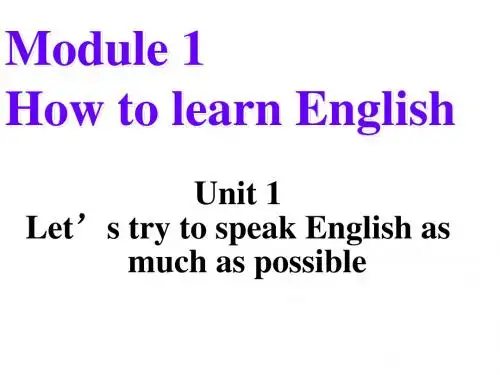
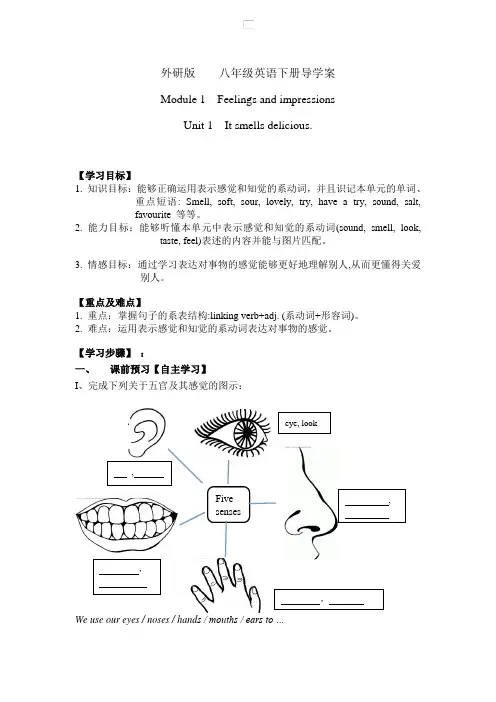
外研版 八年级英语下册导学案Module 1 Feelings and impressionsUnit 1 It smells delicious.【学习目标】1. 知识目标:能够正确运用表示感觉和知觉的系动词,并且识记本单元的单词、重点短语: Smell, soft, sour, lovely, try, have a try, sound, salt,favourite 等等。
2. 能力目标:能够听懂本单元中表示感觉和知觉的系动词(sound, smell, look,taste, feel)表述的内容并能与图片匹配。
3. 情感目标:通过学习表达对事物的感觉能够更好地理解别人,从而更懂得关爱别人。
【重点及难点】1. 重点:掌握句子的系表结构:linking verb+adj. (系动词+形容词)。
2. 难点:运用表示感觉和知觉的系动词表达对事物的感觉。
【学习步骤】 :一、 课前预习【自主学习】I 、完成下列关于五官及其感觉的图示:We use our eyes / noses / hand s / mouths / ears to …Five senses ,, , , eye, lookII.结合课本2页的对话,试着翻译下列词组、重点句子。
1.①②想要做某事2. 在顶部3. 恐怕4. ①②一点儿5. 做完了6. 试试看7. 在中间8. 对甜食的爱好9. 确信10. 草莓酱11. 今天是我的幸运日二、课堂学习过程【合作探究】Step 1. Read the conversation on page 2, and complete the table.food How ... ?looks so nice ,smellstastessmells ,tastestastefeel in the middlesoundcaketastestastesStep 2. Practise speaking like this:E.g. The pizza looks/smells/tastes...【归纳总结】上述句子中的look、smell、taste、feel、sound 叫做,他们与be动词一样也被叫做系动词。
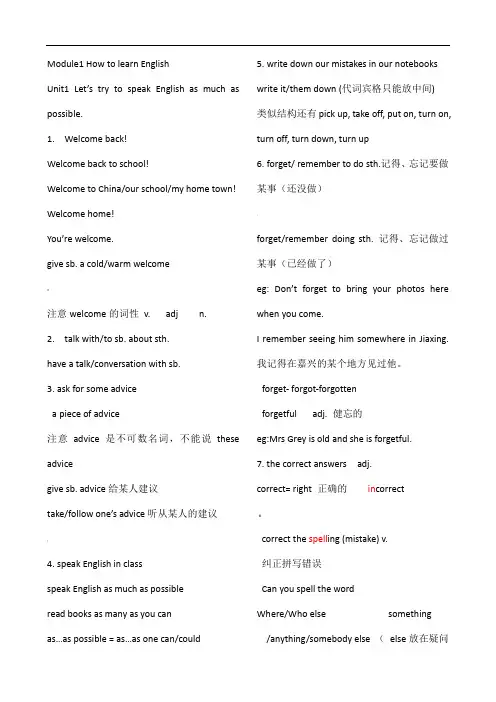
Module1 How to learn EnglishUnit1 Let’s try to speak English as much as possible.1.Welcome back!Welcome back to school!Welcome to China/our school/my home town! Welcome home!You’re welcome.give sb. a cold/warm welcome*注意welcome的词性v. adj n.2.talk with/to sb. about sth.have a talk/conversation with sb.3. ask for some advicea piece of advice注意advice是不可数名词,不能说these advicegive sb. advice给某人建议take/follow one’s advice听从某人的建议;4. speak English in classspeak English as much as possibleread books as many as you canas…as possible = as…as one can/could 5. write down our mistakes in our notebooks write it/them down (代词宾格只能放中间)类似结构还有pick up, take off, put on, turn on, turn off, turn down, turn up6. forget/ remember to do sth.记得、忘记要做某事(还没做)·forget/remember doing sth. 记得、忘记做过某事(已经做了)eg: Don’t forget to bring your photos here when you come.I remember seeing him somewhere in Jiaxing. 我记得在嘉兴的某个地方见过他。
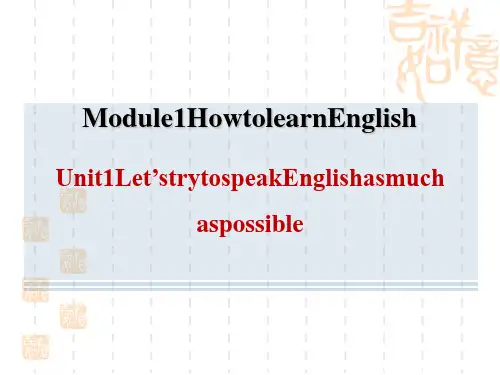
Module1 How to learn English物以类聚,人以群分。
《易经》如海学校陈泽学一、教学内容:Unit 2 You should smile at her!二、课型:Reading and writing三、教学目标:1、能够正确使用下列单词和词组:advise、basic、conversation、improve、natural、meaning、suggest、should、ask for2、能够用should、advise、suggest等词汇提出自己的建议。
3、能够读懂关于英语学习方法及学习建议的文章并获取细节信息。
4、通过阅读,了解如何提高自身英语能力。
四、教学重难点:1、能够读懂文章。
并能在阅读中找出相关的建议,完成任务。
(重点)2、能够正确地提出建议五、教学准备:PPT课件、教学挂图、录音机、课堂联系表格、奖品。
六、教学过程:七、板书设计:八、达标训练题一. 按照句子意思,填入恰当的词。
1. Do you know how to _______ my English?2. Try to _____ the meaning of the new words.3. Our school has a _______ teacher.4. _________ to lock the door when you leave the house.5. I enjoy w_______ English films and l_______ to real English songs.二、单项选择。
1. I like ________ English in the morning.A. readB. to readC. readingD. read2. My friends ask for advice about ___________ their English.A. improveB. to improveC. improvingD. improved3. It takes me a long time _________ the TV play.A. watchB. to watchC. watchingD. watched4. It’s a good way ________ English.A. learnB. to learnC. learningD. learnt5. Try ____________ these words, please.A. rememberB. to rememberC. rememberingD. remembered【素材积累】海明威和他的“硬汉形象”美国作家海明威是一个极具进取精神的硬汉子。
Module 7 A famous storyUnit 1 Alice was sitting with her sister by the river.设计说明教学反思本单元以谈论《爱丽丝漫游奇境记》一书及其作者引入新课。
通过听力练习和对话演练,提升学生的听说和朗读能力。
学习本模块的新单词、短语和句型,学习新语言点,增加学生的语言积累。
从本模块开始学习一个新的时态——过去进行时,在初步学习时从一般过去时和现在进行时引入过去进行时,做好这三个时态的区别。
练习朗读中的重读,提升学生在英语口语表达中的规范性和美感度。
通过对应练习,巩固学生对单词、短语、句型和语法的掌握,提升运用能力。
教学目标通过本单元的教学,让学生达成以下目标:1. 知识目标掌握本单元新单词及短语:fall, follow, hole, rabbit, ssh, ground, tea party。
2. 能力目标(1)能够听懂关于谈论童话故事的对话;用正确的语音、语调朗读对话;(2)学习过去进行时的基本用法。
3. 情感目标通过阅读童话故事及中英文名著的介绍,了解西方国家的文化,汲取其精华。
重点难点重点:对话朗读;过去进行时。
难点:过去进行时。
教学准备PPT课件;《爱丽丝漫游奇境记》及其作者图片;活动1、2、3、5的录音授课时数2课时教学过程Step 1Leading inDiscussion.T: Boys and girls. Do you like reading stories?Ss: Yes, we do.T: Stories are usually interesting. I enjoyed them very much when I was a child.Do you know the book Alice’s Adventures in Wonderland ?Ss: …T: Oh, some children have read the book. Who can tell us something about thebook or the story?Ss: …Show some pictures about the story and its author.Give more information to the class at the same time.Alice’s Adventures in Wonderland is a famous English storybook.Children all over the world like reading it.The English writer Lewis Carroll wrote Alice’sAdventures in Wonderland in the 1960s. The story is also calledAlice in Wonderland.The story is about a girl called Alice. It tells her strange andinteresting experiences in wonderland.Alice, the Cheshire Cat, the March Hare, the Queen of Hearts andthe Mad Hatter are main characters of the story.Step 2Listening1. Finish Activity 1. Listen and number the words as you hear them.(1) Ask someone to read the words. Make sure that all the students understand the meaning.fall follow hole rabbit strange(2) Play the recording and ask the students to write down the numbers 1-5 in the boxes, according to what they hear.(3) Check the answers together.Answers:fall—4; follow—2; hole—5; rabbit—3; strange—12. Finish Activity 2. Listen again and number the pictures.(1) Read the simple descriptions of the pictures to the class. Repeat the names for the students to remember.(2) Ask some students to read the descriptions and the other students to look at the pictures.(3) Play the recording for students and ask them to number the pictures.(4) Check the answers together.Answers:a—2; b—3; c—1(5) Play the recording again. Show the tapescript if necessary.Step 3Listening and readingFinish Activity 3.1. Play the recording. Tell the students to read the conversation as they listen.2. Ask the students to check (√) the true sentences, according to the conversation.1. Lingling is reading Alice’s Adventures in Wonderland. ( )2. The book is about a girl called Alice. ( )3. One day, Alice and her sister saw a white rabbit with a basket.( )4. The March Hare, the Mad Hatter and a mouse were having a tea partyin the garden. ( )5. The Queen of Hearts was sitting in a tree. ( )Answers:1. √ 2. √ 4. √3. Read and complete the notes.1 Alice was ________ with her ________ by the river.2 The white rabbit with a ________ ran past.3 The Mad Hatter, the March Hare and a mouse were having a ________ party.4 The Queen of Hearts was ________ a strange game.(1) Ask the students to read the sentences carefully.(2) Ask them to read the conversation again. Underline the key information while reading.(3) Get the students to complete the sentences from the conversation.(4) Check the answers.Answers:1 sitting, sister2 watch3 tea4 playing4. Read the following phrases and translate them into Chinese.1 one day2 by the river3 fall down4 in a tree5 smile at6 tea party7 play games8 a girl called Alice9 run pastAsk the students to write down the phrases on their notebooks.5. Read the conversation.(1) Ask the students to follow the recording to read the conversation.(2) Tell them to work in pairs. One is Tony, and the other is Daming.(3) Encourage some pairs to read the conversation in different roles.Step 4PracticeFinish Activity 4. Complete the sentences with the words in the box.1 Something is ________ if it is not usual.2 You ________ when you are happy.3 You can wear a ________. It tells you the time.4 A rabbit ________ is a place where rabbits live.5 You ________ when you move down quickly to the ground.(1) Ask the students to read through the words in the box. Make sure they know the meaning of the words.(2) Ask the class to read the sentences and complete them with the words in the box on their own.(3) Check the answers in groups.Answers:1 strange2 smile3 watch4 hole5 fallStep 5Language points1. One day, Alice was sitting with her sister by the river and she saw a white rabbit with a watch. 有一天,爱丽丝正和她的姐姐坐在河边,她看到一只戴着手表的白兔。
Module1 Feelings and impressionsUnit1 It smells delicious.Teaching Content: Listening and Vocabulary and Pronunciation and SpeakingTeaching Aims and Demands:1. Language Knowledgefresh, cookie, try, lovely, done, pie, forKey structure: link verbs + adj.2. Listening skill: To listen to the conversation and understandsentences with senseverbs.3. Speaking skill: To describe things and persons with sense verbs.4. Attitudes: We should help and care for each other.Teaching key and difficult points:Learning strategies:Bottom –up approach and listening to the tape and do some eulti-Media (Tape recorder, video, OHP, handout)Teaching Procedures:Step 1: Warming up1.Listen to a song Heads and shoulders2.Listen and do: Listen to the teacher’s order and do the action,Eg: Touch your nose. Put up your hands.Step2: Presentation1. Show some fruit and cookie, etc to the students and ask them to do look, sound, smell, taste, feel, then ask: Do you like…? How does it/ do they …? Make the students use some adjectives to describe the things like this: They are delicious. It is lovely. The teacher will say: “Yes. They taste delicious. It looks lovely. ”Learn the new words and key structures in this way.2. Pair work1) Work in pairs like this:A: Do you like flowers?B: Yes, I do. They look nice. Do you like cheese?……Practise the key structures.2) Ask some group to make a dialogue in the class. Other studentswrite down the key sentences they make and conclude the rule of sense verbs, like this:[中*&%@国教育~出版网]It smells too strong and it tastes a bit sour. They taste really sweet and they feel soft in the middle.Conclude the rule: sense verbs+/adj./ , i.e.: look, sound,smell, feel, taste+ adj.3.Pronunciation and speaking1)Listen and underline the words the speaker stresses.Step3: Practice1. Listen to the tape and finish Activity1 in the tee students to read the sentences in Activity2 and check the answers.[中~国%&*教育出^版网]3. Listening to the tape of Activity3 and try to answer:a. What does the pizza look like?b. How does the pizza taste?[w#ww.zz%s~@tep^.com]c. What smells delicious?d. What doesn’t smell fresh?e. How does the chocolate cookies taste and feel?4. Listen to the tape and repeat.5. Read the dialogue in roles.6. Game: Catch the thief.7. Fill in the blanks with different sense verbs.1) The pizza ______ sour. 2) The sugar ______ sweet.3) The boy ______ strong. 4) The silk ______ soft.5) The song ______ good.[中国教*育&@^#出版网]Step4: Consolidation1.Finish Activity 4 and 5.2.Finish some ee students to conclude the key point in this lesson. Step5: Homework1.Act out the dialogue in group of 4.2.Copy the new words for 5 times each.3.Preview Unit2Reflections:[来#源:%中^教@网&]1.重点词句在教学过程中的体现不够;2.系表结构句子的归纳欠缺;3.课外练习筛选应补上;4.多做点五个感官动词+adj. 的句型练习。
八年级英语Module 1 Unit1 (1)导学案班级:姓名: _____组_____号导学案编号:课题Unit 1 It smells delicious.课型听说新授课主备人徐琪审核学习目标1.能够正确运用表示感觉和知觉的系动词,并且识记本单元的单词、重点短语: smell, soft, sour, lovely, try, have a try, sound, salt, favourite等。
2.能够听懂本单元中表示感觉和知觉的系动词(sound, smell, look, taste, feel)表述的内容并能与图片匹配。
3.能够运用形容词和相应的感官动词表述物品和人物等的特征。
重点难点1.掌握句子的系表结构: linking verb+adj. (系动词+形容词)。
2.运用表示感觉和知觉的系动词表达对事物的感觉。
导学过程【预习检测,课前准备】闻;闻起来_________ 气味__________ 酸的;馊的________ 软的,柔软的________ 听起来___________ 小甜饼;曲奇饼_________ 比萨饼_________ 令人愉快的;可爱的_________ 馅饼;派_______ 做完的__________ 盐__________ 果酱___________尝一尝;试试看___________ 对甜食的爱好___________【明确目标,情景导入】1. Go over eye, ear, nose, hand, mouth to understand the sense verbs(感官动词): look, sound, smell, feel, taste.2. Talk about some delicious food. How does it look/smell/taste?【学习新知,听力练习】1. Read the new words after the teacher.2. Do Activity1 and 2 on Page2.3. Discuss the use of sense verbs(感官动词) in groups.【学以致用】(1) The coffee tastes ____, would you like some?A. wellB. goodC. badlyD. bad(2) – What do you think of her voice?– I should say it ____ very sweet.A. hearsB. singsC. soundsD. listens4. Listen and answer: What are they talking about?【分层听力,整体感知】1. Listen and check(√) what Betty is making.(on Page3)2. Listen again and complete the table.Food How...?pizza looks so nice and _________ smells _________tastes _________cheese smells _________ tastes _________________ taste ________feel in the middleapple pie sounds _________cakesugar tastes _______________ tastes sweet too.【细读文本,角色练习】1. Read by yourself and answer the questions.(1) Does Daming like the cheese? How do you know?(2) Who has a sweet tooth?2. Read the dialogue together with the tape recorder. Practise reading the dialogue in groups.【设置语境,知识导出】1. Try to retell the dialogue accordi ng to some pictures and the key words.2. Work in pairs. Ask and answer about the things in the box. Say why you like or do not like them. (Act.7)bananas flowers ice cream pop music silk T-shirtsA: Do you like bananas?B: Yes, I do. They taste delicious. Do you like flowers?八年级下英语当堂达标检测内容:Module1 Unit1 (1)姓名:____________ 班级:____________ 分数:____________一、短语默写。
Module 1 How to learn English Unit 1 Let’s try to speak English
as much as possible
姓名_______________ 班级________________
一、listening
Task one: listen and choose the best answer.
1. What are they going to talk about?
A. ways to study English
B. ways to learn Chinese
C. ways to speak English
2. Do you need to understand every word?
A. Yes, I need
B. No, I don’t
C. I don’t know
3. What can you know through reading?
A. I can know a lot about English
B. I can know a lot about the world
C. I can know a lot about the word
Task two: listen again and complete the table.
Work in pairs. Talk about problems in learning English and give advice.
二、
练习
一、短语翻译:
1.欢迎回来____________________________
2.谈论_________________________________
3.学英语的好方式_______________________
4.让我们···____________________________
5.尽力做某事____________________________
6.尽可能多地____________________________
7.为何不···____________________________
8.写下_________________________________
9.忘记做某事____________________________
10.做某事是个好主意_______________________
11.···怎么样呢?
____________________________
12.听收音机_________________________________
13.对···有好处
______________________________
14.对···也是如此
____________________________
15.逐步认识
到···____________________________
16.写信给某人_______________________________
17.同意某人_________________________________
二、句子翻译(表示建议的句型结构)
1.在课堂上,我们应该总是说英语
_______________________________________________________________________________ 2.让我们试着尽可能多地说英语吧
_______________________________________________________________________________ 3.不要忘记把正确答案写在错误的旁边
_______________________________________________________________________________ 4.每天大声拼读新单词是个不错的主意
_______________________________________________________________________________ 5.听收音机怎么样呢?
_______________________________________________________________________________ 6.我们为何不试着找一些英文笔友呢?
_______________________________________________________________________________ 三、Writing.
Mark在学习英语的过程中遇到了一些问题,请你给他一些建议。
文章包括:Mark 在英语学习中遇到的问题,你给他的建议,注意人称、时态。
(写在作文本上)_____________________________________________________________________________________ _____________________________________________________________________________________
_____________________________________________________________________________________ _____________________________________________________________________________________ ____________________________________________________________________________________。